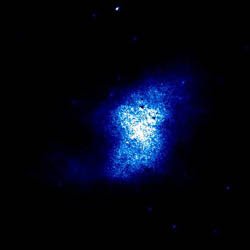The Crab Nebula in the ultraviolet
The Crab Nebula is a supernova remnant located about 6,500 light-years from Earth, in the constellation of Taurus. In the center of the nebula there is a pulsor, the remains of a star that exploded and gave rise to the nebula. This movement approaches 30 revolutions per second and sends a beam of radio waves through the Galaxy. It is believed that the ultraviolet emission is due to 'synchrotron radiation', generated when the atomic particles revolve around the lines of a magnetic field. The Crab Nebula is so energetic that it shines in all known types of light.
Some of the material surrounding the pulsor was ejected before the stellar explosion, while the rest did so during the supernova. The wind of the pulsor escapes at great speed, creating a dynamic structure to interact with the ejected material.
The nebula is expanding to approximately 1,500 km / s, as revealed by the images captured several years apart. Therefore, by backtracking we can identify the year in which the star exploded, which coincides with observations made by Chinese astronomers in the year 1054 of a star bright enough to be seen by day.
The image of the article was taken by ESA's XMM-Newton telescope, which has been studying the heavens since 2000. Its main objective is to observe X-rays, its Optical Monitor allows to make observations in visible and ultraviolet light at the same time as in X-rays. The image consists of 75 snapshots captured between 2001 and 2015. Before this photograph, images of the Crab Nebula are available in the ultraviolet.
It is believed that the star was surrounded by a magnetized material bull before its explosion, which blocked the particles at high speed, which gave rise to the synchrotron radiation. These bays are also seen in the radio images, although the east bay appears better defined, thanks to the intricate formations around the edges of the radio image.

https://mantissocietystudycenter.blogspot.com/2018/03/fwd-la-nebulosa-del-cangrejo-en-el.html
http://noticiasdelaciencia.com/not/27865/la-nebulosa-del-cangrejo-en-el-ultravioleta
http://observatorio.info/1996/09/la-nebulosa-del-cangrejo-en-altas-energias/
Muy interesante. No has averiguado si han capturado esta nebulosa con luz infrarroja?
Excelente tema
Good post. Have an upvote.
I wrote a style guide (link here)for STEM posts that you might find interesting (or not, up to you).
It's good that you source your images otherwise the Steemstem curators might down vote you.